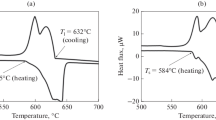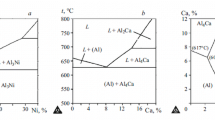Conclusions
-
1.
With concentrations 6\2-6.5% of Ni and up to 0.7\2-0.9% Zr in Al\t-Ni\t-Zr-alloys with real solidification rates it is possible to obtain a structure consisting of primary dendrites of \ga-Al (supersaturated solution of Zr in Al) and eutectic \ga-Al +NiAl3.
-
2.
During decomposition of supersaturated solid solution there is strengthening of Al\t-Ni\t-Zr-alloys due to secondary precipitates of ZrAl3 phase.
The greatest increase in hardness is achieved with a zirconium content of about 0.8% after aging at 400°C.
-
3.
The fine structure of eutectic \ga-Al+NiAl3 promotes an increase in strength with retention of quite a high level of ductility for Al\t-Ni\t-Zr-alloys. Presence in the structure of eutectic provides good casting properties for alloys and a high solidus temperature. This makes it possible to develop on the basis of the composition Al\t-6% Ni\t-0.8% Zr new heat-resistant cast alloys capable of competing with granulated aluminum alloys of the system Al\t-Cr\t-Zr.
Similar content being viewed by others
References
V. I. Dobatkin and V. A. Elagin, Granulated Aluminum Alloys [in Russian], Metallurgiya, Moscow (1981).
A. G. Alieva, M. B. Al'tman, S. M. Ambartsumyan, et al., Commercial Aluminum Alloys: Handbook [in Russian], Metallurgiya, Moscow (1984).
E. J. Lavernia, J. D. Ayers, and T. S. Srivatsan, "Rapid solidification processing with specific application to aluminum alloys," Int. Rev.,37, 1–44 (1992).
V. I. Elagin, V. V. Zakharov, and T. D. Rostova, "Aluminum alloys containing scandium," Metalloved. Term. Obrab. Met., No. 1, 24–28 (1992).
M. E. Drits, L. S. Toropova, and Yu. G. Bykov, "Decomposition of supersaturated solid solution in alloy of the system Al−Sc−Zr," in: Physical Metallurgy, Casting, and Treatment of Cast Alloys [in Russian], VILS, Moscow (1986), pp. 189–195.
W. Dahl, V. Gruhl, W.-G. Burchard, G. Ibe, and C. Dumitrescu, "Solidification and precipitation in Al−Zr-alloys," Z. Metallkunde,68, No. 3, 188–194 (1977).
I. F. Kolobnev, Heat-Resistant Cast Aluminum Alloys [in Russian], Metallurgiya, Moscow (1973).
I. I. Novikov, Hot Shortness of Light Metals and Alloys [in Russian], Nauka, Moscow (1966).
A. G. Spasskii, Bases of Casting Production [in Russian], Metallurgizdat, Moscow (1950).
L. F. Mondol'fo, Structure and Properties of Aluminum Alloys: Handbook [Russian translation], Metallurgiya, Moscow (1979).
M. E. Drits, N. R. Bochvar, É. S. Kadaner, et al., Constitutional Diagrams of Systems Based on Aluminum and Magnesium: Handbook [in Russian], Nauka, Moscow (1977).
A. M. Zakharov, Constitutional Diagrams of Binary and Ternary Systems [in Russian], Metallurgiya, Moscow (1990).
Additional information
Institute of Steels and Alloys, Moscow. Translated from Metallovedenie i Termicheskaya Obrabotka Metallov, No. 10, pp. 19–22, October, 1993.
Rights and permissions
About this article
Cite this article
Belov, N.A. Structure and strength of cast alloys of the system aluminum-nickel-zirconium. Met Sci Heat Treat 35, 572–577 (1993). https://doi.org/10.1007/BF00778668
Issue Date:
DOI: https://doi.org/10.1007/BF00778668




